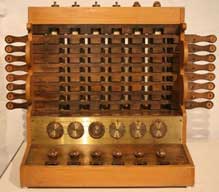HISTORICAL DEVELOPMENT OF COMPUTERS
CONTENT
- Electro-mechanical Counting Devices
Electro-mechanical Counting Devices
These are counting devices that could be operated both electrically and mechanically. Electro-mechanical devices include the following:
- Speeding Clock
- Blaise Pascal machine
- Gottfried Leibniz Machine
SPEEDING CLOCK OR CALCULATING CLOCK
In 1623 and 1624, reported his design and construction of what he referred to as an arithmetical instrument that he has invented but which would later be described as a (calculating clock). The machine was designed to assist in all the four basic functions of arithmetic (addition, subtraction, multiplication and division). Amongst its uses, Schickard suggested it would help in the laborious task of calculating astronomical tables. The machine could add and subtract six-digit numbers, and indicated an overflow of this capacity by ringing a bell. The adding machine in the base was primarily provided to assist in the difficult task of adding or multiplying two multi-digit numbers. To this end an ingenious arrangement of rotatable Napier's bones were mounted on it. It even had an additional "memory register" to record intermediate calculations. Schickard’s machine was not programmable.

- NEW: Download the entire term's content in MS Word document format (1-year plan only)
- The complete lesson note and evaluation questions for this topic
- The complete lessons for the subject and class (First Term, Second Term & Third Term)
- Media-rich, interactive and gamified content
- End-of-lesson objective questions with detailed explanations to force mastery of content
- Simulated termly preparatory examination questions
- Discussion boards on all lessons and subjects
- Guaranteed learning